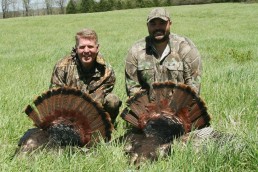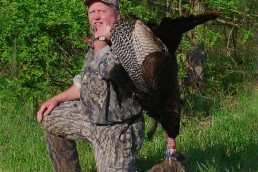Should I Stay or Should I Go?
SHARE THIS POST
‘Run-n-gun’ or ‘staying put’ for springtime toms
In 2004, I had an accident that forever made it difficult for me to sneak through the timber. However, in doing so it forced me to be a more patient turkey hunter. I still like to “run-n-gun” short distances of 1/4 to 1/2 mile I can handle, but let’s face it, for me it’s not “running” and “gunning,” it’s walking slowly and gunning.
Some hunters have no problem sitting all day in front of a decoy spread. I have never been one of those hunters; seeing what was over the next rise was just too alluring to me. So, if I didn’t have an active bird within 30 minutes, my precedent was to pick up my decs and try to strike a gobbler over the rise.
But are you better staying put and hanging on to the hopes that your position will eventually yield an encounter? Or, are you better off searching for a responsive tom? Each outlook has a time and/or a place where it may work best.
For the most part, I consider myself to be a better hunter now than in 2004. Some of that comes from simply being older and having more experience, but some of it comes from the fact that I have learned more by sitting in one spot and observing.
The run-n-gun tactic is one that requires different preparation from sitting in a blind or against an oak all day. When cruising to find a receptive bird, you’ll want to pack light and organize your gear in a quality turkey vest. When covering ground quickly searching for an interested tom, hearing a gobbler can happen fast and you may not have time to search through your gear for whatever tool you may need. You can hear a gobble 70 yards away, need to dive for cover and get ready.
Are you enjoying this post?
You can be among the first to get the latest info on where to go, what to use and how to use it!
If staying put at a decoy setup is your preference, you can pack heavy and comfortable, especially if you’re in a blind, which is important if you’re rooted in one spot. The simple movement of grabbing your Thermos for a cup of coffee can be all it takes to ruin your entire hunt. A blind conceals most movement and doesn’t seem to bother turkeys in the least. If hunting whitetails, I would want my blind to be set up and “brushed-in” well in advance of the hunt so the animals become accustomed to it. With turkeys, I wouldn’t be afraid to set up a blind and immediately hunt out of it.
To some, which tactic they will use is forced upon them. If hunting a small, let’s say a 200-acre parcel, the last thing you want to do is scurry around the property bumping birds onto the other grounds of different neighbors. In this case your best bet is to sit back and do some scouting to find a spot where the birds like to congregate and then make your setup there. It’s easier to call birds into spots they frequent over the spots they normally do not, so scouting is important when “staying put.”
Turkey patterns can be fairly predictable, but these can vary day to day, month to month and even annually. If you have a chance to scout prior to your hunt, or possibly set up cameras, the information obtained can pay off big. If you’re hunting an area that hasn’t been previously scouted, then the run-n-gun option may be a better choice. Again, if you know the birds like to frequent a specific site, then staying put will usually be the best bet.
How they are responding to the call should also have a bearing on whether you move or stay. If you hunt them long enough, you’ll get a bird once in a while that just comes running into your call. On the other hand, it doesn’t take being a turkey hunter for long before you throw your best “set list” at them without a response. When the toms are with their harem it becomes very difficult to call them to you. But once the hens begin nesting, they’ll leave the toms (usually 8:30 a.m. to 10 a.m.) to lay an egg. That’s when gobblers become more vulnerable to your song. So either way—staying or moving—if you have a bird gobbling between mid-morning and noon, chances are he’ll come to the call.
When using run-n-gun you can be more aggressive with your calls too, but over-calling can be the “kiss of death,” especially if you’re in one spot. And from my experience, calling sparsely is usually the best choice when you’ve chosen to stay put. “Read the bird”—sometimes you can be very aggressive, even when sitting still. If the birds react positively, it’s fun to just pour it on.
The run-n-gun technique can be a gamble. There are going to be times when you push too hard. However, with this method the next cooperative bird could be right over the next rise. My best advice is to do some scouting, find out where and when the birds will be the most vulnerable, be flexible in choosing which method best fits your style, terrain, or property size and know the pattern of the birds.
MWO
SHARE THIS POST
Did you enjoy this post?
You can be among the first to get the latest info on where to go, what to use and how to use it!
Todd Amenrud
Todd Amenrud is a full time sportsman whose passion is bowhunting whitetails. He spends considerable time researching whitetails, and has written six books on the subject. Harvesting 47 record-book animals and his ability to share his knowledge have made him one of the Midwest’s most-recognized hunting resources.




